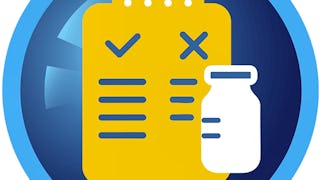While prescription opioids serve an invaluable role for the treatment of cancer pain and pain at the end of life, their overuse for acute and chronic non-cancer pain as well as the increasing availability of heroin and illicit fentanyl, have contributed to the highest rates of overdose and opioid addiction in U.S. history. Evidence-informed solutions are urgently needed to address these issues and to promote high-quality care for those with pain. This course and the report it is based on are a response to that need. They offer timely information and a path forward for all who are committed to addressing injuries and deaths associated with opioids in the United States.

Enjoy unlimited growth with a year of Coursera Plus for $199 (regularly $399). Save now.

Opioid Epidemic: From Evidence to Impact

Instructor: Shannon Frattaroli, PhD, MPH
4,055 already enrolled
Included with
(51 reviews)
What you'll learn
Identify data sources for information about the opioid epidemic in the United States and explain general trends in opioid overdose deaths.
Identify ways that prescription drug monitoring programs (PDMPs) can be used to reduce the supply of prescription opioids
Explain why pharmacy benefit managers are relevant to opioid epidemic
Explain the role of prescribing guidelines, safe storage, treatment, reducing stigma, and product design in opioid epidemic
Skills you'll gain
Details to know

Add to your LinkedIn profile
10 assignments
See how employees at top companies are mastering in-demand skills

There are 10 modules in this course
This module reviews the data available about opioid use disorders in the United States. Information about general trends in opioid overdose, and some limitations of current data systems are discussed. This module draws from section 6 of the "The Opioid Epidemic" report (2017).
What's included
7 videos1 reading1 assignment
This module provides an overview of Prescription Drug Monitoring Programs (PDMPs). Explanations of how PDMPs are used to reduce the supply of prescription opioids likely to be misused are discussed. A review of the research about PDMPs is also included. This module draws from section one of the "The Opioid Epidemic" report (2017).
What's included
1 video1 assignment
This module reviews prescribing guidelines as an intervention for reducing high risk opioid prescribing. A conversation between the course instructors and representatives from CDC’s National Center for Injury Prevention and Control about CDC’s Guideline for Prescribing Opioids for Chronic Pain provides insight into the process of developing and disseminating one guideline. This module aligns with section two of of the "The Opioid Epidemic" report (2017).
What's included
3 videos1 assignment
This module provides an overview of the role of pharmacy benefit managers and pharmacies in the supply of prescription opioids. Opportunities to monitor high risk prescribing through PBMs and pharmacies are also discussed. This module draws from section three of the "The Opioid Epidemic" report (2017).
What's included
1 video1 assignment
This module introduces the idea that redesigning opioid medications and the pill vials they are prescribed in is one strategy to reduce unintentional opioid poisonings and diversion. The module features a discussion of a prototype design for a pill vial engineered to dispense a specified amount of medication at programmed intervals to authorized users. This module aligns with section four of the "The Opioid Epidemic" report (2017).
What's included
3 videos1 assignment
This module reviews strategies for communicating with patients and the public about opioid use disorders. Safe storage and disposal strategies are also discussed. This module draws from section five of the "The Opioid Epidemic" report (2017).
What's included
1 video1 assignment
This module discusses addiction as a disease and medication as treatment. Consideration of known risk factors for disease are also reviewed. This module aligns with section seven of the "The Opioid Epidemic" report (2017).
What's included
8 videos1 assignment
This module describes naloxone, a medication that effectively reverses an opioid overdose, and how access to naloxone has increased. The role of government agencies in disseminating naloxone prescriptions is also highlighted. This module draws from section eight of the "The Opioid Epidemic" report (2017).
What's included
4 videos1 assignment2 plugins
This module provides an overview of harm reduction in the context of opioid use disorders. Examples of harm reduction strategies are provided, and the available evidence discussed. This module aligns with section nine of the "The Opioid Epidemic" report (2017).
What's included
7 videos1 assignment
This module discusses the stigma surrounding drug use and treatment. Strategies for combatting stigma by providing alternatives to stigmatizing language are discussed. This module draws from section 10 of the "The Opioid Epidemic" report (2017).
What's included
4 videos1 assignment
Instructor

Offered by
Explore more from Public Health
 Status: Preview
Status: Preview Status: Free Trial
Status: Free TrialJohns Hopkins University
- Status: Preview
University of Minnesota
 Status: Free Trial
Status: Free TrialUniversity of Colorado Boulder
Why people choose Coursera for their career




Learner reviews
51 reviews
- 5 stars
80.39%
- 4 stars
11.76%
- 3 stars
5.88%
- 2 stars
0%
- 1 star
1.96%
Showing 3 of 51
Reviewed on May 22, 2020
Amazing course! I have learned so much from the wide array of lecturers and I am now planning on specialising on this subject through my MPH next year
Reviewed on Mar 13, 2023
A wealth of information. I enjoyed this course and would be very interested in taking similar courses.
Reviewed on Aug 23, 2022
This course was very helpful in understanding the extent of the problem and the kind of solutions that can be there. It will help me to look at the issue in a different light.

Open new doors with Coursera Plus
Unlimited access to 10,000+ world-class courses, hands-on projects, and job-ready certificate programs - all included in your subscription
Advance your career with an online degree
Earn a degree from world-class universities - 100% online
Join over 3,400 global companies that choose Coursera for Business
Upskill your employees to excel in the digital economy
Frequently asked questions
To access the course materials, assignments and to earn a Certificate, you will need to purchase the Certificate experience when you enroll in a course. You can try a Free Trial instead, or apply for Financial Aid. The course may offer 'Full Course, No Certificate' instead. This option lets you see all course materials, submit required assessments, and get a final grade. This also means that you will not be able to purchase a Certificate experience.
When you purchase a Certificate you get access to all course materials, including graded assignments. Upon completing the course, your electronic Certificate will be added to your Accomplishments page - from there, you can print your Certificate or add it to your LinkedIn profile.
Yes. In select learning programs, you can apply for financial aid or a scholarship if you can’t afford the enrollment fee. If fin aid or scholarship is available for your learning program selection, you’ll find a link to apply on the description page.
More questions
Financial aid available,


